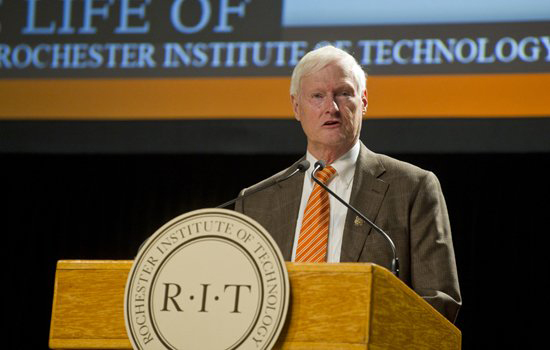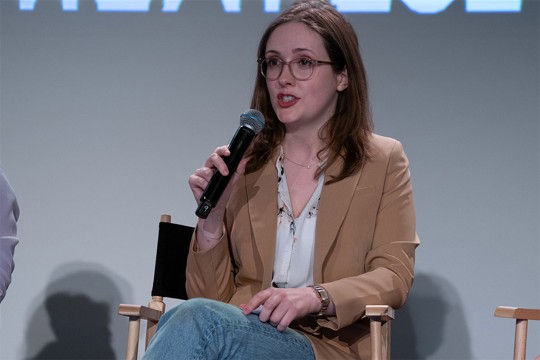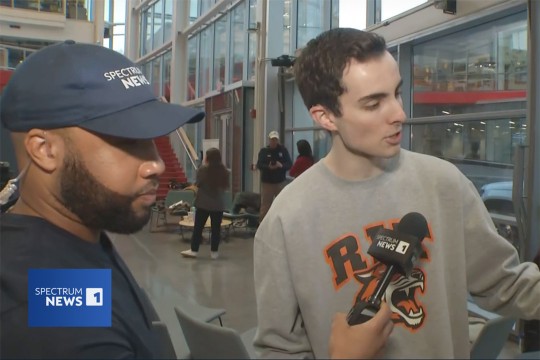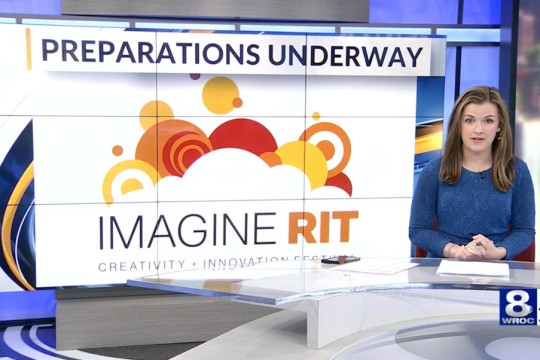First impressions
RIT’s new president shares his thoughts and plans
A. Sue Weisler
On his first day as RIT president, Bill Destler is greeted by Student Government President Ed Wolf during a welcome event organized by Student Government.
Bill Destler officially began his new duties as RIT's ninth president on July 2. He talked about this new chapter in his life – and in the history of RIT – in an interview with The University Magazine.
What attracted you to RIT?
I was initially attracted to RIT by the extraordinary range of academic and research programs underway at the university – programs that include the traditional engineering, science and technology programs expected at any “institute of technology,” but which at RIT are complemented by strong programs in business, in the humanities and social sciences, and in the creative and design arts. This unique combination of programs, together with the very special diversity brought to RIT by the National Technical Institute for the Deaf, seem to me to make RIT a national treasure. Recently, I have also been enormously impressed by the faculty and staff that I have met at RIT. Their dedication, warmth, and concern for their students are surely one of RIT’s greatest assets.
In your 34-year career at the University of Maryland, you climbed the ranks from research associate to senior vice president for academic affairs and provost. What key lessons have you learned that you will bring to RIT?
One of the most important lessons I have learned is to avoid confusing the importance of the position I hold with my own importance. I have learned that if I make decisions based on what I believe is in the best interests of the university and its students, faculty, staff, alumni and other stakeholders, rather than my own personal interests, then I can make a contribution. Academic administrators often get into trouble when they don’t follow that simple rule.
RIT adopted a strategic plan in 2005 that serves as a roadmap through 2015. What do you find most interesting and exciting in the strategic plan?
The over-arching theme of the 2005 strategic plan, that RIT aims to become a “Category of One” university rather than seeking to emulate other institutions, is particularly exciting to me. It is an indication that RIT is “comfortable in its own clothes,” and maps out, at least in my opinion, the most viable road to national eminence.
What do you see as your top three priorities in the 2007-2008 academic year?
First, to do no harm. I will need to immerse myself in the RIT community, learn as much as I can about the university and its students, faculty, staff, alumni and other stakeholders, find out who the key contributors are, and find out what I can do to help them. Second, to engage the RIT community in a discussion about how we might make experience with innovative or creative work or original research and scholarship a defining characteristic of an RIT education for all undergraduate and graduate students. And finally, to engage as many of our alumni and friends as I can in an effort to move this extraordinary institution into the ranks of the nation’s very best universities.
How do you plan to engage alumni in the coming year?
I am going to invest considerable time and effort in the next year in getting out across the country (and the world!) to meet with alumni and friends to try to get them excited about what RIT has become under Dr. Simone’s leadership and what the future might hold for the university if we are willing to set our sights high. Every great university is supported by a loyal and involved alumni base, and getting more of our alumni and friends involved with the institution in a meaningful way will be one of my highest priorities.
You have started conversations on campus related to creativity and innovation. What do you hope to accomplish in these areas?
RIT’s unusual mix of programs in technology, business and the creative and design arts makes it uniquely qualified to become a national center for creativity and innovation. If we are able to mix RIT’s strong emphasis on career-oriented education with the expectation that RIT graduates would all have experienced the excitement associated with innovative or creative work or original research and scholarship, then we will have created an institution uniquely capable of supporting the future economic growth of the Rochester region, of New York state and the nation.
You have also brought up the notion of RIT serving business and industry with research and development. What is your vision here?
Corporate America has given up on all but the shortest-term research and development efforts because of the need to compete with lower-cost producers overseas. The enormous research capabilities in our colleges and universities might provide a low-cost alternative to in-house R&D efforts for American companies were it not for conflicts over intellectual property rights associated with industry-funded research and the longer-time scales typically associated with university research programs. If RIT is willing to be more flexible on the intellectual property issue, its strong industry ties, coupled to a faculty with considerable industrial experience and many industry-focused undergraduate and master’s degree programs, can make the university an unusually agile partner in corporate research and development programs.
What are the unique contributions that RIT can make to the region, the nation and the world?
RIT can, and should, become the Rochester area’s greatest economic asset both as a source of highly trained workers for the local economy and as a source of new ideas that result in the formation of new companies offering a variety of new products and services. On the national and international scenes, RIT can become a model of how a modern university can grow the next generation of entrepreneurs and artists whose creative energies will feed economic growth and address the complex problems facing an increasingly global society.
How do you see your role in terms of working with the Rochester community?
I am looking forward to helping to strengthen the greater Rochester community by working with its leaders, as did Dr. Simone. In this manner I can continue to learn how RIT can be an even greater contributor to Rochester and the prosperity of its citizens.
Tell us a little about your family and your interests outside of work.
My wife, Rebecca Johnson, holds a Ph.D. in psychology and she is looking forward enthusiastically to joining the RIT community and finding ways in which she can contribute. We have two sons: Walter, who is a senior at the University of Maryland studying computer science and theater, and Nathan, who has just completed high school and is planning to enter college next year. I am an avid collector of antique American banjos and I have lately taken an interest in alternative personal transportation options including hybrid and all-electric vehicles.















